|
|
|
Sort Order |
|
|
|
Items / Page
|
|
|
|
|
|
|
| Srl | Item |
| 1 |
ID:
145755
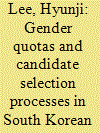

|
|
|
|
|
| Summary/Abstract |
South Korea is one of the few East Asian countries in which candidate gender quotas are legislated for all levels of government. However, the implementation of quotas has been only partially successful as political parties do not comply with quota laws in the majoritarian tier of the country’s mixed-member electoral system. To explain this non-compliance, this article examines how Korea’s party organizations and candidate selection practices have subverted quota implementation. More specifically, we employ Rahat and Hazan’s framework that disaggregates candidate selection processes into four areas—the selectorate, candidacy, centralization, and voting vs. appointment—and examine how two major Korean parties have chosen their candidates in the last three elections. By doing so, we demonstrate that in Korea’s under-institutionalized parties, where party organizations have been overshadowed by individual personalities, implementation of quotas can easily be subordinated to the clientelistic incentives of party leaders. While the parties’ centralized and exclusionary candidate selection procedures give party leaders a great deal of latitude to implement quotas, a better gender balance in the set of candidates is rarely a top priority for leaders in parties where personalism prevails. We argue that this explains why the quotas in Korea have been ineffective.
|
|
|
|
|
|
|
|
|
|
|
|
|
|
|
|
| 2 |
ID:
145753
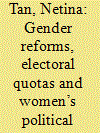

|
|
|
|
|
| Summary/Abstract |
In the last two decades, more than 118 countries and political parties around the world have introduced gender quotas to guarantee women’s political representation. While the study of gender quotas and electoral systems is an exciting field, few studies have focused on East Asia. Why do traditionally male-dominated parties engage in gender reforms? Have gender reforms improved women’s political representation and participation? To address these questions, this introductory article offers an overview of the electoral rules, gender quotas, and candidate selection methods adopted in three broadly similar cases with different outcomes in Taiwan, South Korea, and Singapore. Taiwan and South Korea introduced mixed electoral systems and legislated candidate quotas to improve women’s legislative representation at the local and national levels. Singapore resisted legislating gender quotas while the ruling party voluntarily introduced a party quota in 2009. These gender equality strategies have brought slow and uneven results. Based on qualitative and quantitative methods as well as survey and electoral data, this paper offers new evidence showing why the effects of electoral systems and quota strategies are not automatic or mechanical, but dependent on the degree of party system institutionalization, electoral competitiveness, legal enforcement, and social-cultural attitudes toward women.
|
|
|
|
|
|
|
|
|
|
|
|
|
|
|
|
| 3 |
ID:
145752
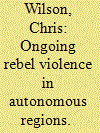

|
|
|
|
|
| Summary/Abstract |
In the large body of literature on the granting of regional autonomy to end insurgency, an important related question has received little attention: what happens to other ethnic groups within the autonomous region? The new arrangement may end violence between the state and the guerrillas but will the latter simply turn their guns on other groups in the area? This article begins to fill this gap in the literature through a close examination of two mass killings conducted by rebels awarded an autonomous region in western Assam, Northeast India. Why would these militants—having won such far-reaching political and economic rewards after a decade of civil war—continue violence and risk these hard-won gains? I propose that violence against other ethnic communities in the new region is more likely in the presence of two main conditions. First, when the community receiving autonomy is a minority in the new region, and second, when only one militant faction is awarded power.
|
|
|
|
|
|
|
|
|
|
|
|
|
|
|
|
| 4 |
ID:
149177
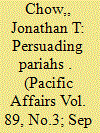

|
|
|
|
|
| Summary/Abstract |
Myanmar’s liberalizing reforms since late 2010 have effectively shed the country’s decades-long “pariah state” status. This article evaluates competing explanations for why Myanmar’s leaders made the strategic decision to pursue reform and opening. We examine whether the strategic decision was motivated by fears of sudden regime change, by socialization into the norms of the Association of Southeast Asian Nations (ASEAN), or by the geopolitics of overreliance on China. Drawing on newly available materials and recent field interviews in Myanmar, we demonstrate how difficult it is for international actors to persuade a pariah state through sanctions or engagement, given the pariah regime’s intense focus on maintaining power. However, reliance on a more powerful neighbour can reach a point where costs to national autonomy become unacceptable, motivating reforms for the sake of economic and diplomatic diversification.
|
|
|
|
|
|
|
|
|
|
|
|
|
|
|
|
| 5 |
ID:
145754
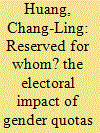

|
|
|
|
|
| Summary/Abstract |
Since the 1990s, gender quotas in elections have become a global phenomenon.
One of the issues raised about gender quotas concerns the qualifications of quota women. A previous study that looked at France’s parity law showed quota women are as competent as or even more competent than non-quota women or non-quota men. The French experience, under the proportional representation system, only allows for a comparison of average qualifications between quota women and their non-quota counterparts.
|
|
|
|
|
|
|
|
|
|
|
|
|
|
|
|
| 6 |
ID:
145751
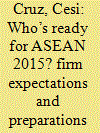

|
|
|
|
|
| Summary/Abstract |
New-new trade theory makes predictions regarding the types of firms most likely to benefit from increases in economic openness. This paper exploits the launch of the ASEAN Economic Community in 2015 to test predictions regarding the types of firms that are optimistic about, and prepared for, increased regional integration.
|
|
|
|
|
|
|
|
|
|
|
|
|
|
|
|
| 7 |
ID:
145756
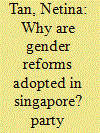

|
|
|
|
|
| Summary/Abstract |
In Singapore, the percentage of elected female politicians rose from 3.8 percent in 1984 to 22.5 percent after the 2015 general election. After years of exclusion, why were gender reforms adopted and how did they lead to more women in political office? Unlike South Korea and Taiwan, this paper shows that in Singapore party pragmatism rather than international diffusion of gender equality norms, feminist lobbying, or rival party pressures drove gender reforms. It is argued that the ruling People’s Action Party’s (PAP) strategic and electoral calculations to maintain hegemonic rule drove its policy u-turn to nominate an average of about 17.6 percent female candidates in the last three elections. Similar to the PAP’s bid to capture women voters in the 1959 elections, it had to alter its patriarchal, conservative image to appeal to the younger, progressive electorate in the 2000s. Additionally, Singapore’s electoral system that includes multi-member constituencies based on plurality party bloc vote rule also makes it easier to include women and diversify the party slate. But despite the strategic and electoral incentives, a gender gap remains. Drawing from a range of public opinion data, this paper explains why traditional gender stereotypes, biased social norms, and unequal family responsibilities may hold women back from full political participation.
|
|
|
|
|
|
|
|
|
|
|
|
|
|
|
|
|
|
|
|
|